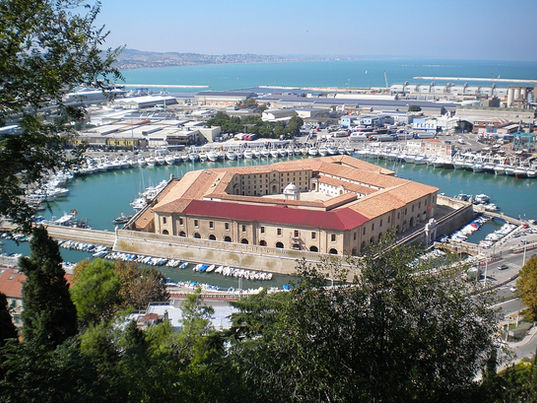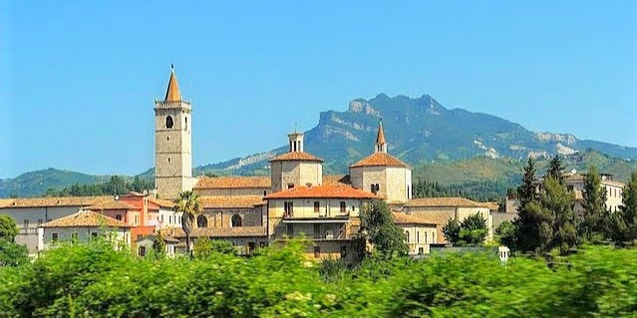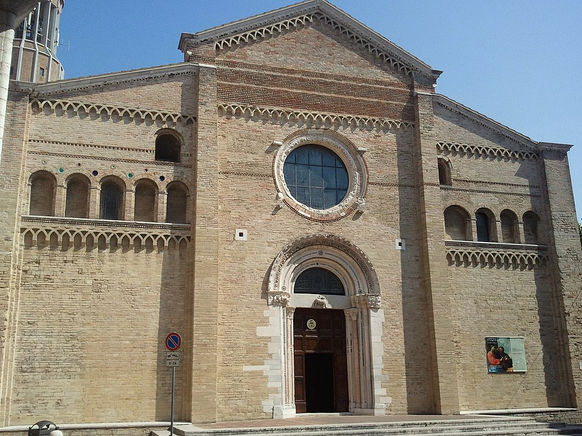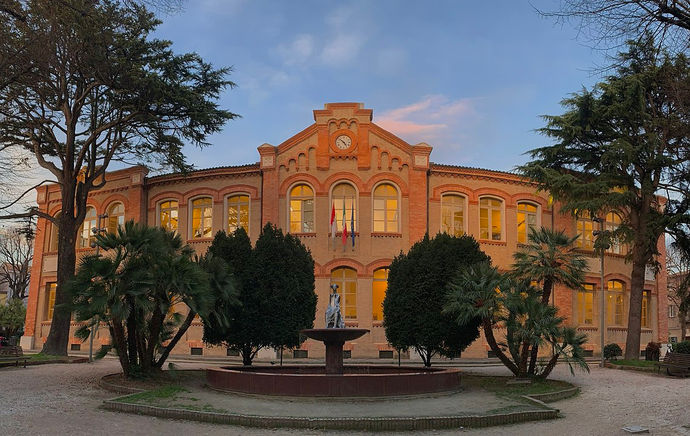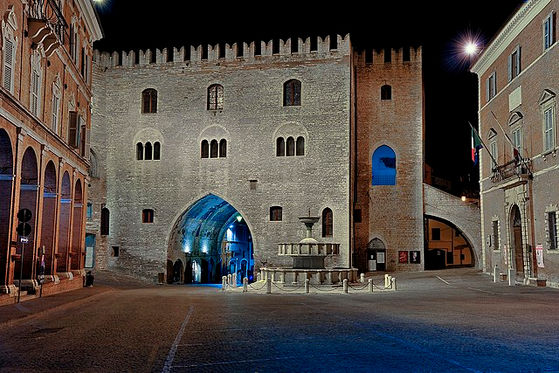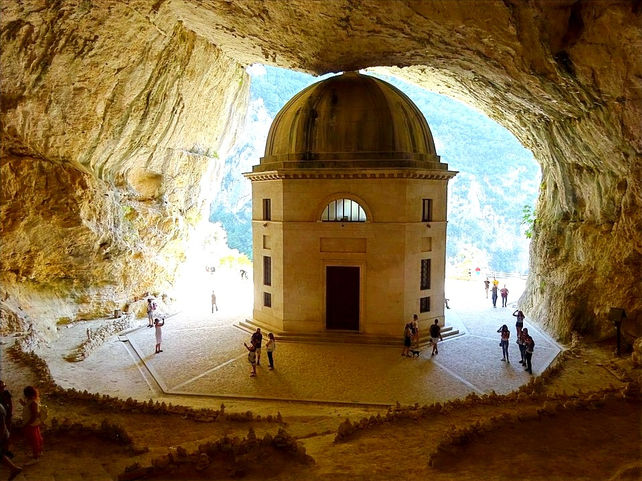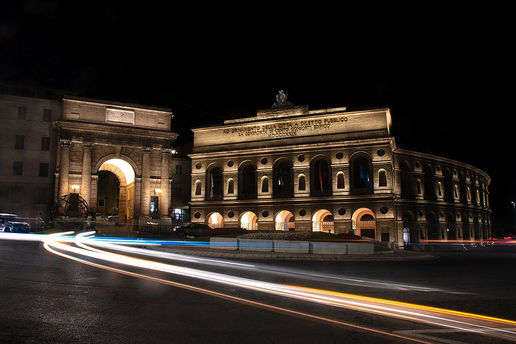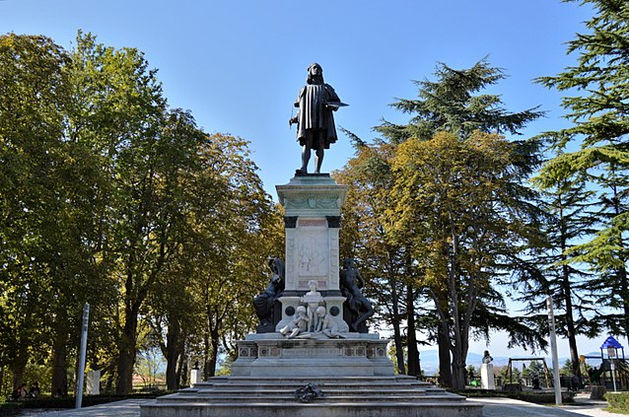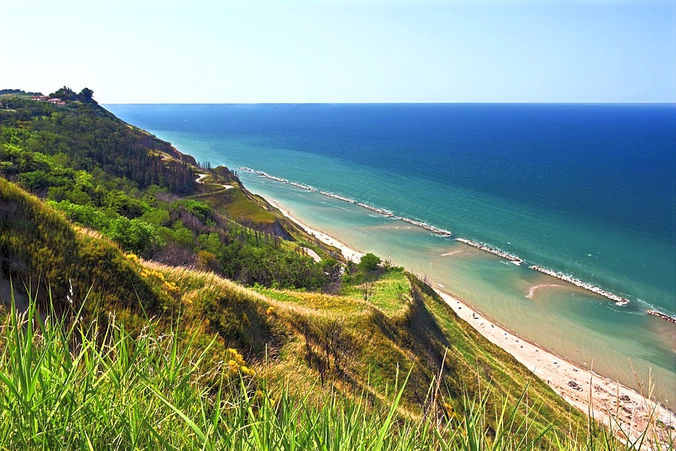

Le Marche
Le Marche region is flanked by the Adriatic Sea and backed by the Apennine mountains. The coastline has a vast strip of sandy, palm-lined beaches and is more populated. On the peaceful mountains, many idyllic walled villages dotted the sparsely populated hills.
One of the more remote and least touristed regions of Italy, making it rarely crowded but authentic, it’s an ideal destination to relax and unwind on a laid-back vacation.
Marche has a long and rich history to discover and a multitude of quaint, tended towns and villages to explore. It has a charm all of its own, an atmosphere that cannot be found anywhere else!
The Marches is full of walled cities. During the 14th and 15th century, Le Marche was transformed into independent states ruled among the noble families and Papal State, and always in conflict one against the other, therefore, defensive fortresses and castles were built throughout the region. Some of these outstanding walled cities are Corinaldo in Ancona province and Gradara in the province of Pesaro-Urbino.
The historical Centre of Urbino is listed as UNESCO World Heritage Sites.
The following towns and villages are among the beautiful villages or major towns in Marche and should be in the bucket list on any Marche’s vacation.
By alex1965 - Pixabay
Ancona
Ancona is a seaside city built on two hills with its harbor between them. It was a bustling port ever since Roman times and even today, it is the main departure point for ferries heading to Croatia, Greece and Turkey. This city lies directly opposite Zadar.
Much of the town is modern and industrial. It was heavily demaged in both World Wars and then hit by an earthquake in 1972 . However, some of its old buildings still remain, such as the Arco di Traiano, built to honour Emperor Trajan, who played an important role in the development of the city. Not far from the cruise terminal is the 18th century Mole Vanvitelliana building. This pentagonal architectural complex was originally built as a quarantine hospital for Leprosy sufferers but is now home to the Tactile museum, where the knowledge of art is transmitted not through sight but through touch.
Piazza del Plebiscito, the main square, is home to several key buildings including the Church of Saint Domenico, the Prefettura di Ancona and the Museo della Citta , and a host of cafes and restaurants. The 11th century Romanesque Cathedral of Saint Ciriaco, located on the top of Monte Guasco, is the most iconic religious structure in the city. It can be seen from a distance. The vista uphill is stunning! Not far from the cathedral are the remains of a Roman amphitheatre and a gladiatorial school. Do not miss the beautiful Caduti Monument dedicated to those who lost their lives during WWI .
Ancona boast some excellent beaches such as the Portonovo Bay, miles of sandy beaches and crystalline water, where you soak up the beautiful sun, or just relax under the shady palm.
Ascoli Piceno
Ascoli Piceno is known as the city of a hundred towers, as historical records show that there are about 200 towers during the Medieval times. There are still over 50 well preserved towers, to be seen today!
One of the unique characteristics of the city is the historic center is built largely out of the grey coloured marble travertine stone extracted from the surrounding mountains, which gleam brilliantly in the afternoon sun.
Piazza del Popolo is one of the most beautiful squares in Italy. A Renaissance square, it is surrounded by buildings with elegant arcades and ornate facades, many of which house cafes and restaurants. Next, Piazza Arringo, the oldest square and several important buildings stand here. It is home to the Pinacoteca, the town’s excellent art museum displaying the ancient Ascoli , with its ancient towers in tact. The imposing Cathedral of St. Emidio stands in one corner, with the Baptistery of San Giovanni next to it.
Corinaldo
Corinaldo is picture-perfect hilltop village, built in the shape of a heart hence its name which is derived from the Latin Cor in Altum ‘Heart on High’. It was voted as one of 'Italy's prettiest village' in 2007. Surrounded by a 14th century walls, it was divided into two sections by a massive 104 steps staircase , called the La Piaggia. Located at the center of La Piaggia there is a famous well, called the Polenta well. According to legend, a famer was climbing the stairs with a corn flour sack on his shoulders, and decided to stop at the well for a rest . He put the sack on the well's edge, unfortunately the sack tumbled down into it. The poor man tried to save it and went down into the well himself , and he was never to be seen again! Some of Corinaldo’s wonders including the Church of the Addolorata, Church of Santa Maria Goretti, neo classical Town hall, as well as the beautiful little opera house, the Teatro Goldoni.
Fano
Fano is a pretty coastal fishing town dating back to Roman times when it was founded by Julius Caesar in 49 BC. It has the two excellent beaches– the Spiaggia Lido and the Spiaggia Sassonia, both have been awarded the famous Blue Flag status.
The town boasts some excellent restaurants, which not surprisingly specialize in fish. Make sure you try the famous fish soup (brodetta alla fanese) washed down with the unique fisherman’s coffee (moretta) which is a tasty blend of anise, rum
and brandy.
The central piazza has a 16th-century fountain , the church of Saint Silvestro and the beautiful Gothic Palazzo del Podesta which was built for the city’s Medieval rulers and which is now in part the city’s opera house, the Teatro della Fortuna.
Frasassi Cave
Another attraction of Marche region is the largest cave system in Europe, the Frasassi Cave. Over 1.4 million years old, the caves were discovered in 1971, measures 18 km, however, only 1 kilometre is open to public. A fairly easy walking cave, with stairs and ramps built around the stunning stalactites and stalagmites. The cave is full of stalagmites that rise up like melted candles and stalactites hanging from the ceiling that resemble a pipe organ. Frasassi were created by the river Sentino. They were formed by a combination of sulphur and water which eroded the rock to create the cave system.
Speleological Museum
Next to the Frasassi Caves, is the Speleological Museum. This has a famous ichthyosaur fossil, which is a rare marine reptile from the Jurassic. It is 3 meters long and it looked like a dolphin.

By Superchilum - wikimedia.org, CC BY-SA 4.0.
Fabriano
The city of Fabriano, famous for the manufacture of paper, a tradition that goes back to the 12th century. It must not be missing from your bucket list. Famous all over the world for its renowned paper mills, Fabriano houses an interesting Museum of Paper and Watermark, where visitors can learn more about the way paper has been produced through the ages. Do not forget, to taste the delicious Fabriano salami too!
Gradara
Gradara is a beautifully preserved Medieval village, perched on a hill with a magnificent fairy-tale castle that dominates the ancient village with its size.
The Gradara Castle, one of the most visited places in Le Marche, is made famous by Dante Alighieri with his Divine Comedy on the two unfortunate lovers, the tragic love story between Paolo and Francesca, just as romantic as Shakespeare's Romeo and Juliet.
Besides visiting the castle, a visit to the Church of San Giovanni Battista is also recommended, home to a 15th century wooden crucifix.


By alex1965 - Pixabay
Gabicce Mare
Nearby Gradara, is the coastal towns of Gabicce Mare, the ideal holiday destinations for families offering hospitality, an array of services, and Blue Flag beaches.

By Pier B-wikimedia.org, CC BY-SA 3.0
Genga
Genga is a tiny Medieval town set deep in the heart of the Rossa-Frasassi Park surrounded by wooded hills. It is famous for the Temple of Valadier and Hermitage of Santa Maria Infra Saxa and San Vittore Abbey . Near Genga, you can’t miss the Frasassi Caves, Europe’s largest and most famous caves complex.
Jesi
Jesi, also spelled Iesi, one of Le Marche's loveliest and liveliest cities, is best known for it's medieval centre and the sturdy walls and towers that surround the town, with defensive fortress dating from its 14th century. The city walls are still intact, and interspersed with gates and towers - the most striking of these is the Tower of Montirozzo. Jesi has many fine buildings and squares, both Baroque and Renaissance. Some highlights are Piazza Federico II, where, according to tradition, the Emperor of Swabia was born. Palazzo della Signoria, formerly the rulers' palace, the Cathedral of Jesi , was erected in the area where in Roman times there was probably a pagan temple. Stroll along Corso Matteotti, with many locals spending their evenings here, having a coffee or drinks with friends, or simply on their evening walk. Take a table on the piazza, sip a glass of Verdicchio di Jesi, one of Italy's most famous white wines and watch the world goes by!
Loreto
Loreto is an important pilgrimage site in Europe, second to Lourdes. The Basilica della Santa Casa is an impressive spectacle but most pilgrims come to visit what it holds inside – the simple house of Virgin Mary, known as The Santa Casa or Holy House. This is a plain stone building that is said to be the house in Nazareth in which the Virgin Mary was born, brought up and received the Annunciation from the angel Gabriel. It is believed to have been brought from Nazareth in the 1290s by the crusaders . Thousands of pilgrims from all over the world visit Loreto each year but even if you are not a Catholic, the basilica is worth a visit for its sheer beauty and historical significance.
Macerata
Macerata is the provincial capital and is home to one of the world’s oldest universities founded in 1290 and its student population certainly gives the city a lively feel. Throughout the city there are many markets, and events that make it a wonderful place to stop by while visiting the region. The town has many lovely mediaeval streets and there are also many beautiful historical buildings , including the Palazzo del Comune, the Palazzo della Prefettura, the Church of San Paolo, the Laura Rossi theatre and the Loggia dei Mercanti, all of which overlook the central Piazza della Liberta. Like many towns and cities in Italy, Macerata roots dated back to Roman times and visitors can also explore the Helvia Recina Roman theatre which dates back to the 2nd century AD.
Macerata holds an opera festival, open-air jazz performances in every summer in the Arena Sferisterio, an incredible neo-classical structure that you simply cannot miss in travelling through Le Marche.
Offida
Offida is famous for its production of fine lace which has been produced here since the 1400s. This traditional lace making using bobbins has been passed from generation to generation and today you can still see women sitting in the street or in their homes moving the tiny bobbins to create their works of art. The village is also famous for its wine production of the increasingly famous Rosso Piceno red wine.
The most important building in Offida is the 14th century Gothic Church of Santa Maria della Rocca, the resting place of St Leonard. It’s a beautiful pale brick built dramatically into the rock, and contains fragments of 14th century frescoes.

By Sgobbone- flickr

Church of Santa Maria della Rocca
By iessi - Flickr, CC BY 2.0
Pesaro
Pesaro is a popular seaside resort, with its modern fully equipped beaches, an attractive historic centre and high end shopping. The most remarkable religious building is the Cathedral, built on the remains of a late Roman building, which boasts an interesting mosaic floor and the city's most flamboyant building is Villino Ruggeri, constructed between 1902 and 1907 for the pharmaceutical industrialist Oreste Ruggeri.
The city is like a contemporary sculpture park, lined with many sculptures from several renowned artists. Among these, the famous “Sfera Grande” Big Sphere, made in bronze by the sculptor Arnaldo Pomodoro in Piazzale Libertà, is becoming a landmark and a popular gathering venue for the city.
Urbino
Your adventure in the Marche must include a thorough visit to the city of Urbino, one of the best preserved cities in Italy, boasts picturesque streets and grandiose palaces. It is the cradle of the Italian Renaissance, listed as UNESCO World Heritage Site since 1998. Here, in the impressive Ducal Palace, you can admire one of the best Renaissance art collections in Italy. Not to be missed is the Birthplace of Raphael, the great artist, who was born right here. There is a monument honouring the great artist at the top of via Raffaello in Piazza Roma. Other attractions not to be missed include Cathedral of Urbino and Church of St. Domenico.The main square Piazza della Repubblica is the meeting point for students as Urbino is, home to one of Italy’s oldest university. The city really is one of the prized Mediaeval jewels of the Le Marche region.
National Parks
Much of the region is equipped with national parks, full of greenery, mountains, and rich views. Here is some of the region’s best main national parks to explore during your visit.
-
Sibillini National Park
-
Conero National Park
-
Gola Della Rossa and Frasassi Regional Park
-
Monte San Bartolo Regional Park
A series of severe earthquakes hit central Italy in the autumn of 2016. The tremors were felt across a large part of Italy, and serious damage was caused in a number of towns and villages in the southern Marche and in neighbouring Umbria and Lazio. Its epicentre was close to Accumoli, a city in the Province of Rieti in the Italian region Lazio.
Following are villages that have been badly affected during the earthquake.
Lazio : Accumoli and Amatrice
Umbria: Norcia, Cascia
Le Marche : Visso, Camerino, and Acquasanta Terme, Arquata del Tronto while Amandola, Sarnano , Maltignano and Calderola have witnessed significant damage
These villages are slowly getting back on their feet. There are still much reconstruction going on. These most affected areas are mostly those most dependent on tourism for their livelihoods, and thus visitors spending really helps the local economy and these cities to rise again! After all, these regions are worth a visit!


